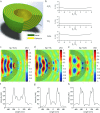Demonstration of nanoimprinted hyperlens array for high-throughput sub-diffraction imaging
- PMID: 28393906
- PMCID: PMC5385565
- DOI: 10.1038/srep46314
Demonstration of nanoimprinted hyperlens array for high-throughput sub-diffraction imaging
Erratum in
-
Corrigendum: Demonstration of nanoimprinted hyperlens array for high-throughput sub-diffraction imaging.Sci Rep. 2017 Aug 24;7:46895. doi: 10.1038/srep46895. Sci Rep. 2017. PMID: 28836623 Free PMC article.
Abstract
Overcoming the resolution limit of conventional optics is regarded as the most important issue in optical imaging science and technology. Although hyperlenses, super-resolution imaging devices based on highly anisotropic dispersion relations that allow the access of high-wavevector components, have recently achieved far-field sub-diffraction imaging in real-time, the previously demonstrated devices have suffered from the extreme difficulties of both the fabrication process and the non-artificial objects placement. This results in restrictions on the practical applications of the hyperlens devices. While implementing large-scale hyperlens arrays in conventional microscopy is desirable to solve such issues, it has not been feasible to fabricate such large-scale hyperlens array with the previously used nanofabrication methods. Here, we suggest a scalable and reliable fabrication process of a large-scale hyperlens device based on direct pattern transfer techniques. We fabricate a 5 cm × 5 cm size hyperlenses array and experimentally demonstrate that it can resolve sub-diffraction features down to 160 nm under 410 nm wavelength visible light. The array-based hyperlens device will provide a simple solution for much more practical far-field and real-time super-resolution imaging which can be widely used in optics, biology, medical science, nanotechnology and other closely related interdisciplinary fields.
Conflict of interest statement
The authors declare no competing financial interests.
Figures







Similar articles
-
Demonstration of a Hyperlens-integrated Microscope and Super-resolution Imaging.J Vis Exp. 2017 Sep 8;(127):55968. doi: 10.3791/55968. J Vis Exp. 2017. PMID: 28930989 Free PMC article.
-
Spherical hyperlens for two-dimensional sub-diffractional imaging at visible frequencies.Nat Commun. 2010;1:143. doi: 10.1038/ncomms1148. Nat Commun. 2010. PMID: 21266993
-
Far-field optical hyperlens magnifying sub-diffraction-limited objects.Science. 2007 Mar 23;315(5819):1686. doi: 10.1126/science.1137368. Science. 2007. PMID: 17379801
-
Metamaterials and imaging.Nano Converg. 2015;2(1):22. doi: 10.1186/s40580-015-0053-7. Epub 2015 Nov 9. Nano Converg. 2015. PMID: 28191408 Free PMC article. Review.
-
Recent advances in super-resolution fluorescence imaging and its applications in biology.J Genet Genomics. 2013 Dec 20;40(12):583-95. doi: 10.1016/j.jgg.2013.11.003. Epub 2013 Nov 23. J Genet Genomics. 2013. PMID: 24377865 Review.
Cited by
-
Demonstration of a Hyperlens-integrated Microscope and Super-resolution Imaging.J Vis Exp. 2017 Sep 8;(127):55968. doi: 10.3791/55968. J Vis Exp. 2017. PMID: 28930989 Free PMC article.
-
Next-Generation Imaging Techniques: Functional and Miniaturized Optical Lenses Based on Metamaterials and Metasurfaces.Micromachines (Basel). 2021 Sep 23;12(10):1142. doi: 10.3390/mi12101142. Micromachines (Basel). 2021. PMID: 34683192 Free PMC article.
-
Metasurfaces-based imaging and applications: from miniaturized optical components to functional imaging platforms.Nanoscale Adv. 2020 Jan 15;2(2):605-625. doi: 10.1039/c9na00751b. eCollection 2020 Feb 18. Nanoscale Adv. 2020. PMID: 36133253 Free PMC article. Review.
-
Nanoimprint lithography for high-throughput fabrication of metasurfaces.Front Optoelectron. 2021 Jun;14(2):229-251. doi: 10.1007/s12200-021-1121-8. Epub 2021 Apr 13. Front Optoelectron. 2021. PMID: 36637666 Free PMC article. Review.
-
Generation of highly integrated multiple vivid colours using a three-dimensional broadband perfect absorber.Sci Rep. 2019 Oct 16;9(1):14859. doi: 10.1038/s41598-019-49906-3. Sci Rep. 2019. PMID: 31619698 Free PMC article.
References
-
- Abbe E. Beiträge zur Theorie des Mikroskops und der mikroskopischen Wahrnehmung. Archiv für mikroskopische Anatomie 9, 413–418 (1873).
-
- Hillenbrand R. & Keilmann F. Optical oscillation modes of plasmon particles observed in direct space by phase-contrast near-field microscopy. Appl. Phys. B 73, 239–243 (2001).
-
- Betzig E., Trautman J. K., Harris T. D., Weiner J. S. & Kostelak R. L. Breaking the diffraction barrier: Optical microscopy on a nanometric scale. Science 251, 1468–1470 (1991). - PubMed
-
- Hell S. W. Toward fluorescence nanoscopy. Nat. Biotechnol. 21, 1347–1355 (2003). - PubMed
Publication types
LinkOut - more resources
Full Text Sources
Other Literature Sources

